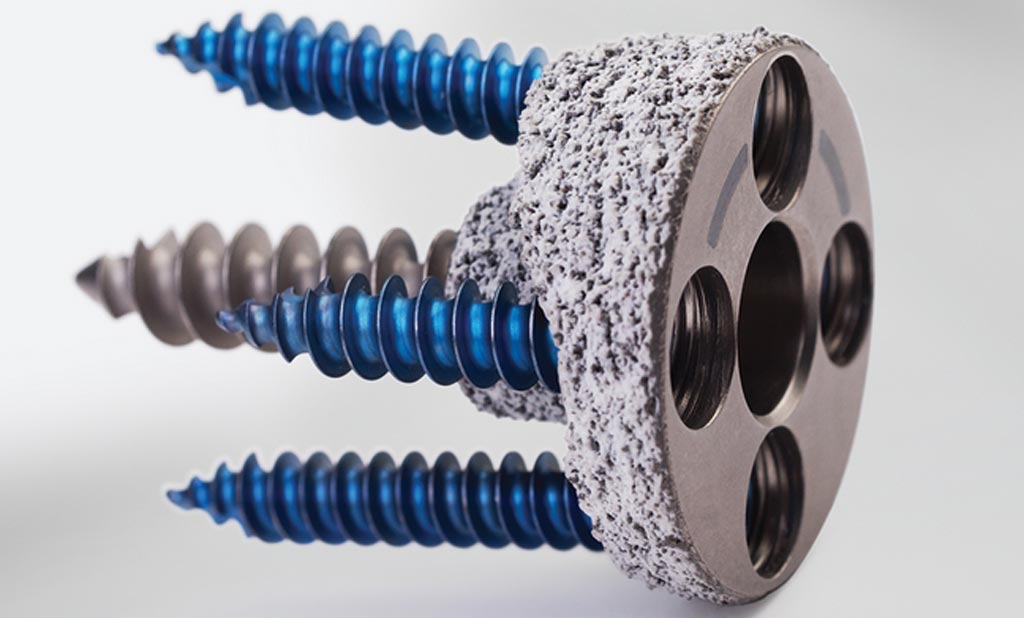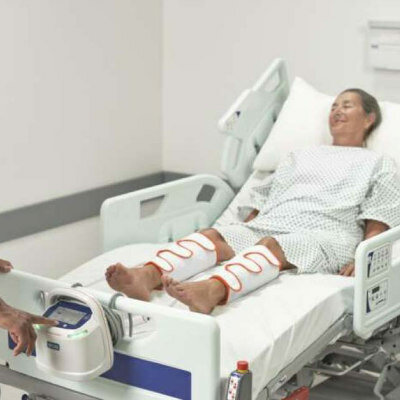Augmented Baseplate Preserves Bone During Reconstruction
|
By HospiMedica International staff writers Posted on 16 Apr 2018 |

Image: The Comprehensive Augmented Baseplate (Photo courtesy of Zimmer-Biomet).
A simplified baseplate for shoulder reconstruction procedures offers an alternative to bone grafting and eccentric reaming for patients with glenoid defects.
The Zimmer Biomet (Warsaw, IN, USA) Comprehensive Augmented Baseplate boasts a simplified circular design at three augment heights (3, 5, and 7mm), allowing placement in any orientation to accommodate various bone anatomies and the full spectrum of glenoid bone wear. The circular design also permits bone ingrowth into the rim of the baseplate for optimal fixation. Features include a modular 6.5 mm central compression screw for enhanced stability; a central boss for sharing the sheer load being transferred to the glenoid; and tricalcium phosphate/hydroxyapatite (TCP-HA) layered over a polyphenylene sulfide (PPS) coating for fixation.
By providing relevant sizing, it also allows a conservative approach to bone removal, thus preserving bone stock if (and when) a future revision procedure becomes necessary, and minimizing the potential challenges of removing well-fixed humeral stems by allowing conversion to a reverse shoulder using any of the existing Comprehensive stems. The Comprehensive Augmented Baseplate is a component of the Comprehensive Reverse Shoulder System, a next-generation reverse shoulder prosthesis engineered to offer high-quality intraoperative flexibility.
“The new Augmented Baseplate rounds out Zimmer Biomet's Comprehensive Shoulder portfolio and provides solutions that help surgeons with difficult glenoid deformity cases,” said Orsa Britton, vice president and general manager of Zimmer Biomet's global Extremities business.
Up to 50% of patients presenting with osteoarthritis and associated rotator cuff arthroplasty have bone erosion that must undergo reconstruction in order to achieve successful shoulder arthroplasty. For those with a lesser degree of bone loss or correction, an augmented baseplate can provide benefits such as reduced bone removal, preservation of cortical bone, and lateralization. An augmented baseplate also provides a simple, reproducible method to restore the glenoid during future reconstruction by reverse shoulder arthroplasty.
Related Links:
Zimmer Biomet
The Zimmer Biomet (Warsaw, IN, USA) Comprehensive Augmented Baseplate boasts a simplified circular design at three augment heights (3, 5, and 7mm), allowing placement in any orientation to accommodate various bone anatomies and the full spectrum of glenoid bone wear. The circular design also permits bone ingrowth into the rim of the baseplate for optimal fixation. Features include a modular 6.5 mm central compression screw for enhanced stability; a central boss for sharing the sheer load being transferred to the glenoid; and tricalcium phosphate/hydroxyapatite (TCP-HA) layered over a polyphenylene sulfide (PPS) coating for fixation.
By providing relevant sizing, it also allows a conservative approach to bone removal, thus preserving bone stock if (and when) a future revision procedure becomes necessary, and minimizing the potential challenges of removing well-fixed humeral stems by allowing conversion to a reverse shoulder using any of the existing Comprehensive stems. The Comprehensive Augmented Baseplate is a component of the Comprehensive Reverse Shoulder System, a next-generation reverse shoulder prosthesis engineered to offer high-quality intraoperative flexibility.
“The new Augmented Baseplate rounds out Zimmer Biomet's Comprehensive Shoulder portfolio and provides solutions that help surgeons with difficult glenoid deformity cases,” said Orsa Britton, vice president and general manager of Zimmer Biomet's global Extremities business.
Up to 50% of patients presenting with osteoarthritis and associated rotator cuff arthroplasty have bone erosion that must undergo reconstruction in order to achieve successful shoulder arthroplasty. For those with a lesser degree of bone loss or correction, an augmented baseplate can provide benefits such as reduced bone removal, preservation of cortical bone, and lateralization. An augmented baseplate also provides a simple, reproducible method to restore the glenoid during future reconstruction by reverse shoulder arthroplasty.
Related Links:
Zimmer Biomet
Latest Surgical Techniques News
- Robotic Assistant Delivers Ultra-Precision Injections with Rapid Setup Times
- Minimally Invasive Endoscopic Surgery Improves Severe Stroke Outcomes
- Novel Glue Prevents Complications After Breast Cancer Surgery
- Breakthrough Brain Implant Enables Safer and More Precise Drug Delivery
- Bioadhesive Sponge Stops Uncontrolled Internal Bleeding During Surgery
- Revolutionary Nano Bone Material to Accelerate Surgery and Healing
- Superior Orthopedic Implants Combat Infections and Quicken Healing After Surgery
- Laser-Based Technique Eliminates Pancreatic Tumors While Protecting Healthy Tissue
- Surgical Treatment of Severe Carotid Artery Stenosis Benefits Blood-Brain Barrier
- Revolutionary Reusable Duodenoscope Introduces 68-Minute Sterilization
- World's First Transcatheter Smart Implant Monitors and Treats Congestion in Heart Failure
- Hybrid Endoscope Marks Breakthrough in Surgical Visualization
- Robot-Assisted Bronchoscope Diagnoses Tiniest and Hardest to Reach Lung Tumors
- Diamond-Titanium Device Paves Way for Smart Implants that Warn of Disease Progression
- 3D Printable Bio-Active Glass Could Serve as Bone Replacement Material
- Spider-Inspired Magnetic Soft Robots to Perform Minimally Invasive GI Tract Procedures
Channels
Critical Care
view channel
CPR Guidelines Updated for Pediatric and Neonatal Emergency Care and Resuscitation
Cardiac arrest in infants and children remains a leading cause of pediatric emergencies, with more than 7,000 out-of-hospital and 20,000 in-hospital cardiac arrests occurring annually in the United States.... Read more
Ingestible Capsule Monitors Intestinal Inflammation
Acute mesenteric ischemia—a life-threatening condition caused by blocked blood flow to the intestines—remains difficult to diagnose early because its symptoms often mimic common digestive problems.... Read more
Wireless Implantable Sensor Enables Continuous Endoleak Monitoring
Endovascular aneurysm repair (EVAR) is a life-saving, minimally invasive treatment for abdominal aortic aneurysms—balloon-like bulges in the aorta that can rupture with fatal consequences.... Read more
Wearable Patch for Early Skin Cancer Detection to Reduce Unnecessary Biopsies
Skin cancer remains one of the most dangerous and common cancers worldwide, with early detection crucial for improving survival rates. Traditional diagnostic methods—visual inspections, imaging, and biopsies—can... Read morePatient Care
view channel
Revolutionary Automatic IV-Line Flushing Device to Enhance Infusion Care
More than 80% of in-hospital patients receive intravenous (IV) therapy. Every dose of IV medicine delivered in a small volume (<250 mL) infusion bag should be followed by subsequent flushing to ensure... Read more
VR Training Tool Combats Contamination of Portable Medical Equipment
Healthcare-associated infections (HAIs) impact one in every 31 patients, cause nearly 100,000 deaths each year, and cost USD 28.4 billion in direct medical expenses. Notably, up to 75% of these infections... Read more
Portable Biosensor Platform to Reduce Hospital-Acquired Infections
Approximately 4 million patients in the European Union acquire healthcare-associated infections (HAIs) or nosocomial infections each year, with around 37,000 deaths directly resulting from these infections,... Read moreFirst-Of-Its-Kind Portable Germicidal Light Technology Disinfects High-Touch Clinical Surfaces in Seconds
Reducing healthcare-acquired infections (HAIs) remains a pressing issue within global healthcare systems. In the United States alone, 1.7 million patients contract HAIs annually, leading to approximately... Read moreHealth IT
view channel
Printable Molecule-Selective Nanoparticles Enable Mass Production of Wearable Biosensors
The future of medicine is likely to focus on the personalization of healthcare—understanding exactly what an individual requires and delivering the appropriate combination of nutrients, metabolites, and... Read moreBusiness
view channel
Philips and Masimo Partner to Advance Patient Monitoring Measurement Technologies
Royal Philips (Amsterdam, Netherlands) and Masimo (Irvine, California, USA) have renewed their multi-year strategic collaboration, combining Philips’ expertise in patient monitoring with Masimo’s noninvasive... Read more
B. Braun Acquires Digital Microsurgery Company True Digital Surgery
The high-end microsurgery market in neurosurgery, spine, and ENT is undergoing a significant transformation. Traditional analog microscopes are giving way to digital exoscopes, which provide improved visualization,... Read more
CMEF 2025 to Promote Holistic and High-Quality Development of Medical and Health Industry
The 92nd China International Medical Equipment Fair (CMEF 2025) Autumn Exhibition is scheduled to be held from September 26 to 29 at the China Import and Export Fair Complex (Canton Fair Complex) in Guangzhou.... Read more












